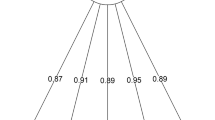Abstract
This paper presents reference values for two questionnaires measuring general health, the General Health Rating Index (GHRI) and the Health Index (HI) and one questionnaire measuring anxiety state, the State Trait Anxiety Inventory (STAI-state). The sample used was randomly selected from a Swedish urban population consisting of 180 individuals (90 men, 90 women), divided into three age groups, 26–45, 46–65 and > 65 years. There was a main effect for age on the total GHRI score. The GHRI score was lower for older than for younger people, which is in agreement with earlier studies. For the HI there were main effects both for gender and age and no interaction was found. Although the sample size is small our result was in agreement to earlier studies and to health statistics in Sweden 1989. The health measures significantly correlated with the scores of anxiety inventory used. The total GHRI scores correlated positively and significantly with the HI scale (r=0.7, p<0.001). The GHRI and HI scales correlated negatively and significantly with the STAI scale (r=−0.4, p<0.001, r=−0.4, p<0.001) respectively. Thus, the better the general health the lower the rated anxiety. The value of health status measures in clinical research is reasonably well established, but their values for clinical care are less clear. The use for health index scores for quality assurance purpose is almost unexplored and could possibly be used for outcome measures in evaluating areas of nursing interventions. The short Health index is one possible outcome measure.
Similar content being viewed by others
References
WareJE, BrookRH, DaviesA, LohrK. Choosing measures of health status for individuals in general populations. Am J Public Health 1981; 71: 620–625.
World Health Organisation. Constitution of the World Health Organisation. In: Basic Documents, Geneva: WHO, 1948.
BrorssonB, IfverJ, HaysRD. The Swedish health-related quality of life survey (SWED-QUAL)—results from adapting and testing an English language health related quality of life meausre. Quality Life Res 1993; 2: 33–45.
BerwickDM, MurphyJM, GoldmanP, WareJ, BarskyA, WeinsteinM. Performance of a five-item mental health screening test. Med Care 1991; 29: 169–76.
SullivanM. Quality of life assessment in medicine. Concepts, definitions, purposes, and basic tools. Nord Psykiatrisk Tidskrift 1992; 46: 79–83.
WareJD Jr. Scales for measuring general health perceptions. Health Serv Res 1976; 11: 394–415.
Hansagi H, Rosenqvist U. Health Index. Department of Social Medicine, Huddinge Hospital. 1982 Unpublished data.
NordströmGM, NymanGR, TheorellT. Psychosocial adjustment and general state of health in patients with ileal conduit urinary diversion. Scand J Urol Nephrol 1992; 26: 139–47.
LangiusA, BjörvellH. Oral and pharyngeal cancer patients' perceived sympotoms and health. Cancer Nursing 1993; 16: 214–221.
SpielbergerCD, GorsuchRL, LusheneRE. STAI manual for the state-trait anxiety inventory. Palo Alto, CA: Consulting Psychologist Press, 1970.
SpielbergerCD. The measurement of state and trait anxiety: conceptual and methodological issues. In: LeviL, ed. Emotions—Their Parameters and Measurement. New York: Raven Press, 1975: 713–725.
WallensteinS, ZuckerCL, FleissJL. Some statistical methods useful in circulation research. Circ Res 1980; 47: 1–9.
NelsonE, HaysRD, ArnoldS, KwohK. SherbourneS. Age and Functional Health Status. Report P-7570, June 1989. Santa Monica, The RAND Corporation: 1989.
Health in Sweden. Yearbook of Health Statistics 91/92. Statistics Sweden SCB 1991.
CronbachLJ. Coefficient alpha and the internal structure of tests. Psykometrika 1951; 16: 297–334.
PolitD, HunglerB. Nursing Research: Principles and Methods. London: B Lippincott Co., 1987.
Author information
Authors and Affiliations
Rights and permissions
About this article
Cite this article
Forsberg, C., Björvell, H. Swedish population norms for the GHRI, HI and STAI-state. Qual Life Res 2, 349–356 (1993). https://doi.org/10.1007/BF00449430
Received:
Accepted:
Issue Date:
DOI: https://doi.org/10.1007/BF00449430




